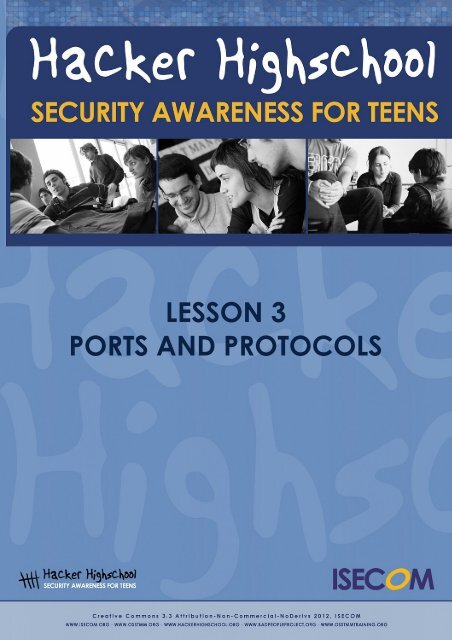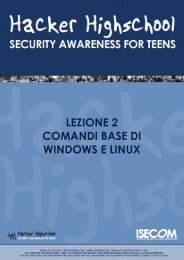Lesson 03 - Ports and Protocols - Hacker Highschool
Lesson 03 - Ports and Protocols - Hacker Highschool
Lesson 03 - Ports and Protocols - Hacker Highschool
Create successful ePaper yourself
Turn your PDF publications into a flip-book with our unique Google optimized e-Paper software.
LESSON 3<br />
PORTS AND PROTOCOLS
2<br />
<strong>Lesson</strong> 3: <strong>Ports</strong> <strong>and</strong> <strong>Protocols</strong><br />
WARNING<br />
The <strong>Hacker</strong> <strong>Highschool</strong> Project is a learning tool <strong>and</strong> as with any learning tool there are<br />
dangers. Some lessons, if abused, may result in physical injury. Some additional dangers<br />
may also exist where there is not enough research on possible effects of emanations from<br />
particular technologies. Students using these lessons should be supervised yet<br />
encouraged to learn, try, <strong>and</strong> do. However ISECOM cannot accept responsibility for how<br />
any information herein is abused.<br />
The following lessons <strong>and</strong> workbooks are open <strong>and</strong> publicly available under the following<br />
terms <strong>and</strong> conditions of ISECOM:<br />
All works in the <strong>Hacker</strong> <strong>Highschool</strong> Project are provided for non-commercial use with<br />
elementary school students, junior high school students, <strong>and</strong> high school students whether<br />
in a public institution, private institution, or a part of home-schooling. These materials may<br />
not be reproduced for sale in any form. The provision of any class, course, training, or<br />
camp with these materials for which a fee is charged is expressly forbidden without a<br />
license, including college classes, university classes, trade-school classes, summer or<br />
computer camps, <strong>and</strong> similar. To purchase a license, visit the LICENSE section of the HHS<br />
web page at http://www.hackerhighschool.org/licensing.html.<br />
The <strong>Hacker</strong> <strong>Highschool</strong> Project is an open community effort <strong>and</strong> if you find value in this<br />
project, we ask that you support us through the purchase of a license, a donation, or<br />
sponsorship.
3<br />
<strong>Lesson</strong> 3: <strong>Ports</strong> <strong>and</strong> <strong>Protocols</strong><br />
Table of Contents<br />
WARNING............................................................................................................................................... 2<br />
Contributors........................................................................................................................................... 4<br />
Introduction <strong>and</strong> Objectives................................................................................................................ 5<br />
Basic Concepts of Networking............................................................................................................ 6<br />
Devices.............................................................................................................................................. 6<br />
Topologies......................................................................................................................................... 6<br />
Game On: Leaving the Back Door Open...................................................................................... 7<br />
The TCP/IP (DoD) Model....................................................................................................................... 9<br />
Layers................................................................................................................................................. 9<br />
Application.................................................................................................................................. 9<br />
Transport.................................................................................................................................... 10<br />
Internetwork.............................................................................................................................. 10<br />
Network Access........................................................................................................................ 10<br />
Feed Your Head: See “The OSI Model”........................................................................................ 10<br />
<strong>Protocols</strong>.......................................................................................................................................... 10<br />
Application layer protocols..................................................................................................... 11<br />
Transport layer protocols.......................................................................................................... 11<br />
Internet layer protocols............................................................................................................ 11<br />
Internet Control <strong>and</strong> Management Protocol (ICMP)............................................................11<br />
IPv4 Addresses................................................................................................................................. 12<br />
Classes............................................................................................................................................. 13<br />
Loopback Addresses...................................................................................................................... 15<br />
Network Addresses......................................................................................................................... 15<br />
Broadcast Addresses...................................................................................................................... 15<br />
<strong>Ports</strong>.................................................................................................................................................. 15<br />
Encapsulation................................................................................................................................. 18<br />
Feed Your Head: The OSI Model....................................................................................................... 22
4<br />
<strong>Lesson</strong> 3: <strong>Ports</strong> <strong>and</strong> <strong>Protocols</strong><br />
Contributors<br />
Marta Barceló, ISECOM<br />
Pete Herzog, ISECOM<br />
Glenn Norman, ISECOM<br />
Chuck Truett, ISECOM<br />
Bob Monroe, ISECOM<br />
Kim Truett, ISECOM<br />
Gary Axten, ISECOM<br />
Marco Ivaldi, ISECOM<br />
Simone Onofri, ISECOM<br />
Greg Playle, ISECOM<br />
Tom Thomas, ISECOM<br />
Mario Platt<br />
Ryan Oberto, Johannesburg South Africa<br />
Vadim Chakryan, Ukraine<br />
Peter Houppermans
5<br />
<strong>Lesson</strong> 3: <strong>Ports</strong> <strong>and</strong> <strong>Protocols</strong><br />
Introduction <strong>and</strong> Objectives<br />
In the far depths of the past, before there was an Internet, electronic communication was<br />
pure voodoo. Every computer manufacturer had their own idea about how machines<br />
should talk over a wire. And nobody even considered the possibility that a Wang<br />
computer might communicate with a Burroughs machine.<br />
The world changed when scientists <strong>and</strong> students experienced the joy of using a terminal<br />
to access a mainframe computer. The famous IBM PC arrived, <strong>and</strong> quickly owners wanted<br />
to access that mainframe from their personal computer. Soon modems were making dialup<br />
connections <strong>and</strong> users were working in terminal emulators. Networking had graduated<br />
to a Black Art, <strong>and</strong> the insiders were called (really) gurus.<br />
The world shifted again dramatically when the Internet, which started as a military project,<br />
was opened to the public. Networking had always been local, meaning confined to one<br />
office or at most one campus. How were all these different systems going to talk?<br />
The answer was “wedge” a universal address system into existing networks, a system we<br />
generally call Internet Protocol (IP). Think about it this way: imagine your friend overseas<br />
sends you a package. That package may travel by plane, train or automobile, but you<br />
don't really need to know the airline schedule or the location of the nearest train station.<br />
Your package will eventually arrive at your street address, which is ultimately the only thing<br />
that matters. Your IP address is a lot like this: packets may travel as electrons, beams of<br />
light or radio waves, but those systems don't matter to you. All that matters is your IP<br />
address, <strong>and</strong> the IP address of the system with which you're talking.<br />
One thing that complicates this idea in the real world is that more than one person may<br />
be living at a single address. In the networking world, that's what's happening when one<br />
server provides for instance both regular HTTP <strong>and</strong> secure HTTPS, as well as FTP. Notice the<br />
P at or near the end of those acronyms? That's always a dead giveaway for protocol,<br />
which is just another way of saying “a type of communication.”<br />
This lesson will help you underst<strong>and</strong> how protocols <strong>and</strong> their ports work in Windows, Linux,<br />
<strong>and</strong> OSX. You'll also become familiar with several utilities (some of which have already<br />
been introduced in the previous lesson) that explore your system's networking capabilities.<br />
At the end of the lesson you should have a basic knowledge of:<br />
• the concepts of networks <strong>and</strong> how communication takes place<br />
• IP addresses<br />
• ports <strong>and</strong> protocols
6<br />
<strong>Lesson</strong> 3: <strong>Ports</strong> <strong>and</strong> <strong>Protocols</strong><br />
Basic Concepts of Networking<br />
The starting point for networking is the local area network (LAN). LANs let computers in a<br />
common physical location share resources like printers <strong>and</strong> drive space, <strong>and</strong><br />
administrators control that access. Sections below describe common network devices<br />
<strong>and</strong> topologies.<br />
Devices<br />
Going forward in your career as a hacker, you're going to see a lot of network diagrams.<br />
It's useful to recognize the most common symbols:<br />
Figure 3.1: Common Network Symbols<br />
A hub is like an old-fashioned telephone party line: everybody is on the same wire, <strong>and</strong><br />
can hear everyone else's conversations. This can make a LAN noisy fast.<br />
A switch is better: it filters traffic so that only the two computers talking to each other can<br />
hear the conversation. But like a hub, it's used only on a LAN.<br />
A router sits between LANs; it's used to access other networks <strong>and</strong> the Internet, <strong>and</strong> it uses<br />
IP addresses. It looks at the packets being sent <strong>and</strong> decides which network those packets<br />
belong on. If the packet belongs on the “other” network, like a traffic police, it sends the<br />
packet where it belongs.<br />
Topologies<br />
A topology is just another way of saying “the way we connect it”. The kind of decisions we<br />
make regarding our topology can affect positively as well as negatively in the future,<br />
depending on technologies being used, technological <strong>and</strong> physical constraints,<br />
performance <strong>and</strong> security requirements, size <strong>and</strong> nature of the organization, etc.<br />
A LAN's physical structure can look like any of the following physical topologies:
7<br />
<strong>Lesson</strong> 3: <strong>Ports</strong> <strong>and</strong> <strong>Protocols</strong><br />
Bus Ring Star Extended Star Hierarchic<br />
Figure 3.2: Toplogies<br />
In a bus topology, all the computers are connected to a single cable, <strong>and</strong> each<br />
computer can communicate directly with any of the others. But break any part of the bus,<br />
<strong>and</strong> everyone's off the network.<br />
In the ring configuration, each computer is connected to the following one, <strong>and</strong> the last<br />
one to the first, <strong>and</strong> each computer can only communicate directly with the two<br />
adjacent computers.<br />
Bus topologies are rarely used nowadays. Ring technologies are often used at the interstate<br />
level, usually with two counter rotating rings, sending traffic in opposite directions, for<br />
reliability <strong>and</strong> fault tolerance.<br />
In the star topology, none of the computers are directly connected with others. Instead<br />
they are connected through a hub or switch that relays information from computer to<br />
computer.<br />
If several hubs or switches are connected to each other, you get an extended star<br />
topology.<br />
In a star or extended star topology, all the central points are peers, that is, they're<br />
essentially equals. This is the most common LAN topology today.<br />
However, if you connect two star or extended star networks together using a central point<br />
that controls or limits traffic between the two networks, then you have a hierarchical<br />
network topology. This is the topology usually deployed in bigger enterprises.<br />
Game On: Leaving the Back Door Open<br />
In the sun-baked heat of the summer, Jace was happy to help the local airconditioned<br />
police department set up their small network. They paid her with cookies,<br />
time away from the heat, conversation <strong>and</strong> the opportunity to install backdoors.<br />
Crawling under steel work desks that hadn't been moved in decades, Jace had<br />
found the cruddiest hidden spot to hide a wifi access point. She'd just plugged it in<br />
<strong>and</strong> sprinkled trash on top of it, <strong>and</strong> was dragging a roll of Ethernet cable to the wall<br />
ports she'd installed earlier.<br />
A heavy h<strong>and</strong> slapped the desk above her. Jace kicked metal <strong>and</strong> yelled “Ow! My<br />
head!” then added, “you sure you don't want me to set up your server?”<br />
The cop cleared his throat <strong>and</strong> tried to put on a Dork Professor voice. “Well I would,<br />
but I'm not sure how the flux ray resistor would hold up to the micro-channel cross<br />
feeds. Especially when the full moon falls on the last Tuesday of the month.”<br />
Jace flapped her feet in mock teen irritation. “Apparently you have no problem
8<br />
<strong>Lesson</strong> 3: <strong>Ports</strong> <strong>and</strong> <strong>Protocols</strong><br />
achieving quantum levels of baloney. And when do I get my cookies, Officer<br />
Kickam?”<br />
“Jace please, please call me Hank. You make me feel like an old man when you call<br />
me Officer Kickam.” He tried to sound hurt but she knew social engineering when she<br />
heard it: he was really trying to distract her from the cookies.<br />
“Hank, hate to break the news to you, but you are an old man.”<br />
“Ouch, that hurt. I am not old, I am distinguished,” he countered, considering his<br />
highly polished black police shoes as Jace's tattered sneaks disappeared under the<br />
heavy desk. Then cinnamon brown eyes <strong>and</strong> a face covered in spider webs<br />
emerged. Jace still had a reel of cable under one arm. Hank helped her up <strong>and</strong><br />
brushed the bug webs off her face <strong>and</strong> shoulders.<br />
“Help, police brutality,” Jace teased.<br />
“Hostile criminal,” Hank returned. “So educate me on your diabolical plan here,” the<br />
hairy muscled lawman asked in what almost sounded to Jace like a pleading tone.<br />
That felt good, so she asked, “Are you sure you want to know about this networking<br />
stuff?” He nodded eagerly. Jace thought: bobble head.<br />
“Okay, what I did was design a network topography, like a map that shows where all<br />
the equipment, computers, hubs, jacks, switches, routers <strong>and</strong> firewalls will go. You<br />
can't start a project like this without a map,” she said, glancing up at the cop. “It's all<br />
about making sure every node can talk to every other node, with no single point of<br />
failure. So, like, a bus architecture stinks, because if one node in the bus goes down,<br />
everyone else does too.” Hank nodded so Jace continued.<br />
“Think like networking is this cop shop, uh, police station, <strong>and</strong> someone just brought in<br />
a suspect. Every cop deserves their fair turn to beat up on the guy without hogging<br />
someone else's time. If the victim, I mean suspect, is moved to another cell, all the<br />
cops who still need to beat on the dude have to know where he went.”<br />
“Oh Jace, you're gonna start looking like you need a good beating too if you keep<br />
talking like that about us peace officers.” Hank pulled up his gun belt <strong>and</strong> sucked in<br />
his slight belly.<br />
Jace snorted a laugh. “So the suspect is a data packet <strong>and</strong> you police thugs are the<br />
network devices. And every device, a switch, a router, firewall, another server or<br />
whatever, needs to know that the data packet gets dealt with. You know, pummeled<br />
with police batons. I think you called it giving someone a wood shampoo.”<br />
Hank rolled his eyes <strong>and</strong> groped for the baton that he didn't have on him.<br />
Giggling, Jace brought up the reel of cable like a shield. “Hey, I've got a spool of wire<br />
<strong>and</strong> I'm not afraid to use it. Put down the cup of coffee <strong>and</strong> nobody gets hurt.” Off<br />
balance <strong>and</strong> laughing, Jace flopped onto Hank, who didn't budge. Wow, this guy is<br />
a total rock, she realized. The h<strong>and</strong> he laid on her shoulder reminded her of …<br />
something.<br />
She stood a little too quickly, reddening. “So there's two kinds of devices. Smart<br />
devices <strong>and</strong> dumb ones. Just like cops.” Four approaching uniforms appeared at<br />
exactly the wrong time to hear the “dumb ones, just like cops.” Lamely Jace<br />
continued, “Smart devices remember everything they do. They keep logs of their<br />
activities.”<br />
“And the dumb ones? Like cops?” asked the Chief of Police.
9<br />
<strong>Lesson</strong> 3: <strong>Ports</strong> <strong>and</strong> <strong>Protocols</strong><br />
Game Over<br />
The TCP/IP (DoD) Model<br />
TCP/IP was developed by the DoD (Department of Defense) of the United States <strong>and</strong><br />
DARPA (Defense Advanced Research Project Agency) in the 1970s. TCP/IP was designed<br />
to be an open st<strong>and</strong>ard that anyone could use to connect computers together <strong>and</strong><br />
exchange information between them. Ultimately, it became the basis for the Internet.<br />
Generally, the simplest form of the TCP/IP model is called the DoD Model, <strong>and</strong> that's<br />
where we'll start.<br />
Layers<br />
The simple DoD model defines four totally independent layers into which it divides the<br />
process of communication between two devices. The layers that pass information are:<br />
Application<br />
Figure 3.3: The DoD Model<br />
The application layer is exactly what you probably think it is: the layer where applications<br />
like Firefox, Opera, email clients, social networking sites, instant messaging <strong>and</strong> chat<br />
applications work. Actually quite a few applications access the Internet: some office<br />
applications, for instance, connect to online collections of clip art. The application layer
10<br />
<strong>Lesson</strong> 3: <strong>Ports</strong> <strong>and</strong> <strong>Protocols</strong><br />
creates the payload that all the other layers carry. A good analogy is a postal system. The<br />
application creates the package that it wraps with instructions on how the package<br />
should be used. Then it h<strong>and</strong>s off the package to the mail room: the Transport layer.<br />
Transport<br />
The transport layer sets up network connections, which are called sessions. In the world of<br />
the Internet, the primary protocol at the Transport layer is TCP, the Transmission Control<br />
Protocol. TCP adds another “wrapping” to the outside of the package, with instructions<br />
about which package it is (say, 1 of 3), how to make sure the package got there, <strong>and</strong><br />
whether the package is intact.<br />
Let's say you're going to email a letter to your mother. The letter may be tiny or huge, but<br />
it's too big to send over the Internet in one piece. Instead, TCP breaks up that letter into<br />
segments, small chunks that are consecutively numbered, with a little bit of error-checking<br />
code at the end. If a packet gets corrupted in transit, TCP requests a retransmission. At the<br />
receiving end, TCP puts the pieces back together in the correct order <strong>and</strong> your mother<br />
gets the letter in her email.<br />
But don't forget that TCP isn't the only game in town: UDP also functions at this layer, <strong>and</strong> in<br />
particular it does NOT create sessions. It just shoots a stream of datagrams, which are<br />
similar to segments, but UDP never checks if you've received it.<br />
Whether TCP or UDP, all traffic is assigned to specific port numbers at this layer.<br />
Internetwork<br />
This layer adds information about the source <strong>and</strong> destination addresses, <strong>and</strong> where the<br />
packet begins <strong>and</strong> ends. It's like a delivery company that gets packages to the correct<br />
address. It doesn't care if all the packets make it, or if they are intact; that's the Transport<br />
layer's job. The major protocol at this level is, appropriately, IP (Internet Protocol). And this<br />
is the layer that uses IP addresses to get packets to the right place by the best route.<br />
Network Access<br />
This layer is the low-level physical network that you use to connect to the Internet. If you're<br />
dialing up, we're sorry, <strong>and</strong> you're using a simple PPP connection. If you have DSL you may<br />
be using ATM or Metro Ethernet. And if you have cable Internet you're using a DOCSIS<br />
physical network. It doesn't matter what kind you use, because TCP/IP makes everything<br />
work together. The network access layer consists of the Ethernet cable <strong>and</strong> network<br />
interface card (NIC), or the wireless card <strong>and</strong> access point. It h<strong>and</strong>les the lowest level<br />
ones <strong>and</strong> zeroes (bits) as they go from one point to another.<br />
Feed Your Head: See “The OSI Model”<br />
See “The OSI Model” at the end of this lesson for an<br />
alternative take on network modeling.<br />
<strong>Protocols</strong><br />
So now you're connected to the Internet. That seems simple enough, but consider the<br />
usual situation you're in: you are conducting innocent, important research on the Internet,<br />
while your dear brother or sister is wasting time streaming a movie. Why don't these two<br />
streams of traffic get mixed up? How does the network tell them apart?
11<br />
<strong>Lesson</strong> 3: <strong>Ports</strong> <strong>and</strong> <strong>Protocols</strong><br />
The answer is protocols, which are like languages that different kinds of traffic speaks. Web<br />
traffic uses one protocol, file transfers another one, <strong>and</strong> email a different one still. Like all<br />
things digital, protocols don't really use names down at the network level; they use IP<br />
addresses <strong>and</strong> port numbers.<br />
Application layer protocols<br />
FTP or File Transfer Protocol is used for the transmission of files between two devices. It uses<br />
one port to deliver data, <strong>and</strong> another port to send control signals (“I got the file! Thanks!”).<br />
The most commonly used ports are 20 <strong>and</strong> 21 (TCP).<br />
HTTP or Hyper-Text Transfer Protocol is used for web pages. This traffic usually uses TCP port<br />
80. HTTPS is a secure variant that encrypts network traffic, usually on TCP port 443.<br />
SMTP or Simple Mail Transfer Protocol is the protocol that sends email. Its TCP port is 25.<br />
DNS or Domain Name Service is how a domain like ISECOM.org gets mapped to an IP<br />
address like 216.92.116.13. It uses port is 53 (UDP).<br />
Transport layer protocols<br />
TCP <strong>and</strong> UDP are the two main protocols used by the transport layer to transfer data.<br />
TCP or Transmission Control Protocol establishes a logical connection (a session) between<br />
two hosts on a network. It sets up this connection using the three-way h<strong>and</strong>shake.<br />
1. When my computer wants to connect with yours, it sends a SYN packet, which is<br />
basically saying, “Let's synchronize clocks so we can exchange traffic with<br />
timestamps.”<br />
2. Your computer (if it's going to accept the connection) responds with a SYN/ACK<br />
acknowledgment packet.<br />
3. My computer seals the deal with an ACK packet, <strong>and</strong> we're connected.<br />
But this happens only with TCP. Instead, UDP or User Datagram Protocol is a transport<br />
protocol that doesn't even care if you have a connection. It's like a fire hose: if you catch<br />
the stream you catch it, <strong>and</strong> if you don't, you don't. This makes UDP very fast, so it's useful<br />
for things like streaming voice <strong>and</strong> video, where missing a single frame doesn't matter<br />
much or online gaming, where missing a single frame doesn't matter much (depending<br />
on which side of the bullet you are).<br />
Internet layer protocols<br />
IP or Internet Protocol serves as a universal protocol to allow any two computers to<br />
communicate through any network at any time. It's like the postal carrier who delivers<br />
mail; all it does is get packets to their destination address.<br />
Internet Control <strong>and</strong> Management Protocol (ICMP)<br />
ICMP is the protocol that the network devices <strong>and</strong> network administrators use to<br />
troubleshoot <strong>and</strong> maintain the network. It includes things like ping (Packet InterNet<br />
Groper) <strong>and</strong> similar comm<strong>and</strong>s that test the network <strong>and</strong> report errors. Because people<br />
have used things like ping floods to bring down hosts <strong>and</strong> networks, most systems limit<br />
ICMP to one response per second.<br />
To summarize, ports <strong>and</strong> protocols come together like this:
12<br />
<strong>Lesson</strong> 3: <strong>Ports</strong> <strong>and</strong> <strong>Protocols</strong><br />
Figure 3.4: The TCP/IP Stack<br />
IPv4 Addresses<br />
Domain names are h<strong>and</strong>y for humans, because we're good at remembering names like<br />
ISECOM.org. But networks don't actually underst<strong>and</strong> them; they only underst<strong>and</strong> numeric<br />
IP addresses. So when you ask for ISECOM.org, your computer does a quick lookup using<br />
DNS (Domain Name Service) to find the corresponding IP address.<br />
IP addresses are like street addresses. If you want mail, you have to have one. IPv4<br />
addresses consist of 32 bits that are divided in four 8-bit octets, which are separated by<br />
dots. This means that there are 2 32 (or 4,294,967,296) unique addresses on the Internet<br />
under IPv4. Part of the IP address identifies the network, <strong>and</strong> the remainder of the IP<br />
address identifies the individual computers on the network. Think of these parts as the<br />
country/city (network) portion of the address <strong>and</strong> the street (host) portion of the address.
13<br />
<strong>Lesson</strong> 3: <strong>Ports</strong> <strong>and</strong> <strong>Protocols</strong><br />
Figure 3.5: Network Number <strong>and</strong> Host ID<br />
Returning to the postal service analogy: IP is the delivery truck that gets the packet to the<br />
correct post office. TCP is the outer wrapper with the list of how many packages are in a<br />
shipment, <strong>and</strong> which one this is (say, number 3 of 65). The host-level addresses are the<br />
particular house (computer) for which the packet is destined.<br />
There are both public <strong>and</strong> private (non-routable) IP addresses. Private IP addresses<br />
are used by private networks; routers won't allow these addresses onto the Internet.<br />
IP addresses within a private network should not be duplicated within that network, but<br />
computers on two different – but unconnected – private networks could have the same IP<br />
addresses. The IP addresses that are defined by IANA, the Internet Assigned Numbers<br />
Authority, as being available for private networks (see RFC 1918) are:<br />
10.0.0.0 through 10.255.255.255 (Class A)<br />
172.16.0.0 through 172.31.255.255 (Class B)<br />
192.168.0.0. through 192.168.255.255 (Class C)<br />
Classes<br />
IP addresses are divided into classes based on what portion of the address is used to<br />
identify the network <strong>and</strong> what portion is used to identify the individual computers.<br />
Depending on the size assigned to each part, more devices will be allowed within the<br />
network, or more networks will be allowed. The existing classes are:
14<br />
<strong>Lesson</strong> 3: <strong>Ports</strong> <strong>and</strong> <strong>Protocols</strong><br />
Figure 3.5: IP Class Divisions<br />
Class A: The first bit is always zero, so this class includes the addresses between 0.0.0.0<br />
(which, by convention, is never used) <strong>and</strong> 126.255.255.255. Note: the addresses of 127.x.x.x<br />
are reserved for the services of loopback or localhost (see below).<br />
Class B: The first two bits of the first octet are '10', so this class includes the addresses<br />
between 128.0.0.0 <strong>and</strong> 191.255.255.255.<br />
Class C: The first three bits of the first octet are '110', so this class includes the addresses<br />
between 192.0.0.0 <strong>and</strong> 223.255.255.255.<br />
Class D: The first four bits of the first octet are '1110', so this class includes the addresses<br />
between 224.0.0.0 <strong>and</strong> 239.255.255.255. These addresses are reserved for group multicast<br />
implementations.<br />
The remaining addresses are used for experimentation or for possible future<br />
allocations.<br />
The mask (or netmask) is used to mark these class splits. Down in binary, a '1' bit shows the<br />
part containing the network identification <strong>and</strong> a '0' bit represents the part that identifies<br />
the individual host. The default netmasks for the first three classes are:<br />
255.0.0.0 (Class A)<br />
255.255.0.0 (Class B)<br />
255.255.255.0 (Class C)
15<br />
<strong>Lesson</strong> 3: <strong>Ports</strong> <strong>and</strong> <strong>Protocols</strong><br />
This is actually pretty slick, since networks that use default classes will mask one octet if<br />
they're Class A, two octets for Class B <strong>and</strong> three octets for Class C. Using default classes is<br />
h<strong>and</strong>y – but not everyone's doing it.<br />
What all this means is that to identify a host, you'll need both the IP address <strong>and</strong> a<br />
network mask:<br />
IP: 172.16.1.20<br />
Mask: 255.255.255.0<br />
Loopback Addresses<br />
IP addresses 127.0.0.1 through 127.255.255.254 are reserved to be used as loopback or<br />
localhost addresses, that is, they refer directly back to the local computer. Every<br />
computer has a localhost address of 127.0.0.1, therefore that address cannot be used to<br />
identify different devices.<br />
There are also other addresses that cannot be used. These are the network address <strong>and</strong><br />
the broadcast address.<br />
Network Addresses<br />
The network address is basically the network part of an IP address, with zeroes where the<br />
host part would be. This address cannot be given to a host, because it identifies the whole<br />
network, not just one host.<br />
IP: 172.16.1.0<br />
Mask: 255.255.255.0<br />
Broadcast Addresses<br />
The broadcast address is basically the network part of an IP address, with ones where the<br />
host part would be. This address can't be used to identify a specific host, because it's the<br />
address that all hosts listen to (of course that's what broadcast means: everybody listens).<br />
IP: 172.16.1.255<br />
Mask: 255.255.255.0<br />
<strong>Ports</strong><br />
Both TCP <strong>and</strong> UDP use ports to exchange information with applications. A port is an<br />
extension of an address, like adding an apartment or room number to a street address. A
16<br />
<strong>Lesson</strong> 3: <strong>Ports</strong> <strong>and</strong> <strong>Protocols</strong><br />
letter with a street address will arrive at the correct apartment building, but without the<br />
apartment number, it won't get to the correct recipient.<br />
<strong>Ports</strong> work in the same way. A packet can be delivered to the correct IP address, but<br />
without the associated port, there is no way to determine which application should act on<br />
the packet. A port number is also a 16 bit number, which means it can have decimal<br />
values between 0 <strong>and</strong> 65535 (2 to the power of 16).<br />
Another way to think about this would be: every computer is a post office. Each<br />
application has its own post office box; no two applications should share the same<br />
post office box. The port number is that post office box number.<br />
Port numbers make it possible to have multiple streams of information going to one IP<br />
address, where each one is sent to the appropriate application. The port number lets a<br />
service running on a remote computer know what type of information a local client is<br />
requesting <strong>and</strong> what protocol is used to send that information, all while maintaining<br />
simultaneous communication with a number of different clients.<br />
For example, if a local computer attempts to connect to the website www.osstmm.org,<br />
whose IP address is 62.80.122.2<strong>03</strong>, with a web server running on port 80, the local<br />
computer would connect to the remote computer using the socket address:<br />
62.80.122.2<strong>03</strong>:80<br />
In order to maintain a level of st<strong>and</strong>ardization among the most commonly used ports,<br />
IANA has established that the ports numbered from 0 to 1024 are to be used for common,<br />
privileged or well-known services. The remaining ports – up through 65535 – are used for<br />
dynamic allocations or particular services.<br />
The most commonly used (well-known) ports – as assigned by the IANA – are listed here:<br />
Port Assignments<br />
Number Keywords Description<br />
5 rje Remote Job Entry<br />
0 Reserved<br />
1-4 Unassigned<br />
7 echo Echo<br />
9 discard Discard<br />
11 systat Active Users<br />
13 daytime Daytime<br />
15 netstat Who is Up or NETSTAT<br />
17 qotd Quote of the Day
17<br />
<strong>Lesson</strong> 3: <strong>Ports</strong> <strong>and</strong> <strong>Protocols</strong><br />
Port Assignments<br />
19 chargen Character Generator<br />
20 ftp-data File Transfer [Default Data]<br />
21 ftp File Transfer [Control]<br />
22 ssh SSH Remote Login Protocol<br />
23 telnet Telnet<br />
25 smtp Simple Mail Transfer<br />
37 time Time<br />
39 rlp Resource Location Protocol<br />
42 nameserver Host Name Server<br />
43 nicname Who Is<br />
53 domain Domain Name Server<br />
67 bootps Bootstrap Protocol Server<br />
68 bootpc Bootstrap Protocol Client<br />
69 tftp Trivial File Transfer<br />
70 gopher Gopher<br />
75 any private dial out service<br />
77 any private RJE service<br />
79 finger Finger<br />
80 www-http World Wide Web HTTP<br />
95 supdup SUPDUP<br />
101 hostname NIC Host Name Server<br />
102 iso-tsap ISO-TSAP Class 0<br />
110 pop3 Post Office Protocol - Version 3<br />
113 auth Authentication Service<br />
117 uucp-path UUCP Path Service<br />
119 nntp Network News Transfer Protocol<br />
123 ntp Network Time Protocol<br />
137 netbios-ns NETBIOS Name Service<br />
138 netbios-dgm NETBIOS Datagram Service<br />
139 netbios-ssn NETBIOS Session Service<br />
140-159 Unassigned<br />
160-223 Reserved
18<br />
<strong>Lesson</strong> 3: <strong>Ports</strong> <strong>and</strong> <strong>Protocols</strong><br />
Encapsulation<br />
When a piece of information – an e-mail message, for example – is sent from one<br />
computer to another, it is subject to a series of transformations. The application layer<br />
generates the data, which is then sent to the transport layer.<br />
The transport layer takes this information, breaks in into segments <strong>and</strong> adds a header to<br />
each one, which contains ports, unique number of the segment <strong>and</strong> other session<br />
information.<br />
Then the segment is passed to Network layer where another header is added, containing<br />
the source <strong>and</strong> destination IP addresses <strong>and</strong> more meta-information.<br />
The next layer, which in most local networks is supplied by Ethernet, adds yet another<br />
header, <strong>and</strong> so on. This procedure is known as encapsulation.<br />
Each layer after the first makes its data an encapsulation of the previous layer's data, until<br />
you arrive at the final layer, in which the actual transmission of data occurs. So<br />
encapsulation looks like this:
19<br />
<strong>Lesson</strong> 3: <strong>Ports</strong> <strong>and</strong> <strong>Protocols</strong><br />
Figure 3.6: Encapsulation<br />
When the encapsulated information arrives at its destination, it must then be deencapsulated.<br />
As each layer passes information to the next layer up the stack, it removes<br />
the information contained in the header placed there by that lower layer.<br />
The final bit of information in this great addressing scheme is the absolutely unique address<br />
of the computer's NIC: the Media Access Controller (MAC) address. This address is usually<br />
displayed as six two-character hexadecimal numbers separated by colons or hyphens<br />
(dashes). It is the physical address of the network card <strong>and</strong> supposedly can't be changed<br />
(actually, there are ways to change it, but exactly how is for you to figure out). A MAC<br />
address looks like this:<br />
00-15-00-06-E6-BF
20<br />
<strong>Lesson</strong> 3: <strong>Ports</strong> <strong>and</strong> <strong>Protocols</strong><br />
Exercises<br />
3.1. Using comm<strong>and</strong>s you learned in <strong>Lesson</strong>s 1 <strong>and</strong> 2, get your IP address, netmask, DNS<br />
hostname, <strong>and</strong> MAC address. Compare these with your partners. What seems similar<br />
<strong>and</strong> what is different? Given the IP address scheme the network is using, is this a<br />
private or a public network?<br />
3.2. netstat<br />
The netstat comm<strong>and</strong> tells you your network statistics: with whom you're connected,<br />
how long networking has been up, <strong>and</strong> so forth. In Linux, Windows or OSX you can<br />
open a comm<strong>and</strong> line interface <strong>and</strong> type:<br />
netstat<br />
In the CLI window, you'll see a list of established connections. If you want to see the<br />
connections displayed in numeric form, type:<br />
netstat -n<br />
To see the connections <strong>and</strong> the active (listening, open) ports, type:<br />
netstat -an<br />
To see a list of other options, type:<br />
netstat -h<br />
In the netstat output, look for the columns listing the local <strong>and</strong> remote IP addresses<br />
<strong>and</strong> the ports they're using:<br />
Proto Recv-Q Send-Q Local Address Foreign Address (state)<br />
tcp4 0 0 192.168.2.136.1043 66.220.149.94.443 ESTABLISHED<br />
The ports are the numbers after the regular IP address; they may be separated by dots<br />
or colons. Why are the ports used by the remote address different from the ports used<br />
by the local address?<br />
Open several browser windows or tabs to various websites, then run netstat again.<br />
If there are several tabs open, how does the browser know which information goes to<br />
which tab?<br />
Why is it that when a web browser is used, no listening port is specified?<br />
What protocols are used?<br />
What happens when one protocol gets used in more than one instance?<br />
3.3. My First Server<br />
To perform this exercise, you must have the netcat (nc) program. BackTrack includes it<br />
by default, as does OSX, but you can download installers for various operating<br />
systems.<br />
1. In a CLI window, type:
21<br />
<strong>Lesson</strong> 3: <strong>Ports</strong> <strong>and</strong> <strong>Protocols</strong><br />
nc -h<br />
This displays the options that are available in netcat.<br />
To create a simple server, In Linux or Windows type:<br />
nc -l -p 1234<br />
or in OSX type:<br />
nc -l 1234<br />
You just started a server listening to port 1234.<br />
2. Open a second CLI window <strong>and</strong> type:<br />
netstat –a<br />
This should verify that there is a new service listening on port 1234.<br />
To communicate with a server, you have to have a client! In your second CLI window<br />
type:<br />
nc localhost 1234<br />
This comm<strong>and</strong> makes a connection with the server that's listening to port 1234. Now,<br />
anything that is written in either of the two open CLI windows can be seen in the other<br />
window.<br />
Consider the implications. How could someone abuse this capability to exploit your<br />
machine?<br />
Netcat sends all its traffic in the clear. Is there a secure alternative?<br />
3. Stop your server by going back to the first CLI window <strong>and</strong> typing Control-C.<br />
4. Now create a simple text file named test containing the text, “Welcome to my<br />
server!”<br />
Once you've done that, look at the following comm<strong>and</strong> <strong>and</strong> translate it for the<br />
instructor: what does each part do? Then, in your first CLI window, type:<br />
nc -l -p 1234 < test<br />
From another CLI window, connect to the server by typing:<br />
nc localhost 1234<br />
When the client connects to the server, you should see the output of the file test.<br />
What protocol has been used to connect with the server?<br />
Does netcat allow you to change this? If so, how?
22<br />
<strong>Lesson</strong> 3: <strong>Ports</strong> <strong>and</strong> <strong>Protocols</strong><br />
Feed Your Head: The OSI Model<br />
Figure 3.7: The ISO/OSI Model<br />
The OSI Model was developed in the 1980s (about ten years after the TCP/IP Model) by<br />
ISO, the International St<strong>and</strong>ards Organization. OSI st<strong>and</strong>s for Open Systems<br />
Interconnection, <strong>and</strong> it was an attempt to st<strong>and</strong>ardize networking architecture that<br />
came from an organization that wasn't really involved in the development of<br />
networking.<br />
The OSI Model is a layered model with a h<strong>and</strong>ful of simple rules. Similar functions are<br />
grouped together in the same layer, <strong>and</strong> (please do not forget this) every layer is<br />
serviced by the layer beneath it, <strong>and</strong> serves the layer above it.<br />
This layered model is a good idea, because since every layer (in theory) does its own<br />
communication, new developments in any one layer don't break any of the other<br />
ones. This feature alone may explain the Internet boom we've had since 2000, with<br />
new applications <strong>and</strong> services appearing almost each day.<br />
Besides the two rules of this OSI model we've already discussed (similar functions are<br />
grouped, <strong>and</strong> every layer is serviced by the layer beneath it <strong>and</strong> serves the layer<br />
above it) this st<strong>and</strong>ard has one more strict rule. Every layer involved in communication<br />
from one computer communicates directly with the same layer on the other computer.<br />
This means that when you type www.google.com in your browser, there is a direct<br />
interaction between your computer's Layer 7 interface (your web browser) <strong>and</strong><br />
Google.com's web servers (also a Layer 7 interface), <strong>and</strong> that the same can be said of<br />
any other layer.
23<br />
<strong>Lesson</strong> 3: <strong>Ports</strong> <strong>and</strong> <strong>Protocols</strong><br />
So let's first define what are the OSI model layers <strong>and</strong> their respective responsibilities.<br />
Application Layer<br />
Presentation Layer<br />
Session Layer<br />
Transport Layer<br />
Network Layer<br />
Data Link layer<br />
Physical layer<br />
Responsible for direct interaction between applications <strong>and</strong> the<br />
user interface to the application, for instance the use of a web<br />
browser like IE or Firefox.<br />
Responsible for guaranteeing that data is exchanged in a way<br />
that is comprehensible between both parties. In some services<br />
that use a form of encryption, the encryption happens at the<br />
presentation layer.<br />
Responsible for dialogue control between two computers.<br />
Basically it establishes, manages <strong>and</strong> terminates all connections<br />
that happen between the computers.<br />
Provides transparent transfer of data between computers,<br />
providing reliable data transfer services to the upper layers. This<br />
means that it is responsible for assembling all data in smaller<br />
portions that can be carried reliably on a data network. If a<br />
packet is lost or not received, it is the transport layer's job to make<br />
sure that that single packet is retransmitted <strong>and</strong> then reassembled<br />
in the correct order.<br />
This layer is responsible for the addressing part of the connection.<br />
Not only on ensuring that each address is unique on the network,<br />
but also on making sure that whatever path is available (whether<br />
a good or a bad one), it always delivers the information where it<br />
needs to go, <strong>and</strong> that our information will be sent from hop to hop<br />
until it reaches its final destination.<br />
The data link layer was designed to deal with ensuring the<br />
physical layer can recover from errors that might happen <strong>and</strong> to<br />
deal with different connecting mediums. Basically it prepares<br />
(encapsulates) data so that it can be transmitted over whatever<br />
physical means are necessary (radio waves, fiber-optic cable,<br />
copper).<br />
This layer defines the physical specifications of the devices <strong>and</strong><br />
what needs to be done in order for the information to be<br />
transmitted over the selected medium. For a WiFi connection, this<br />
is a radio signal; for a fiber connection it's the light being sent; or<br />
for a copper connection the electronic signal being sent on the<br />
wire.<br />
These seven layers comprise everything that is needed for the reliable communication<br />
between computers.<br />
Here's how the different models we've discussed look side-by-side:
24<br />
<strong>Lesson</strong> 3: <strong>Ports</strong> <strong>and</strong> <strong>Protocols</strong><br />
Figure 3.8: Networking Models Compared
















